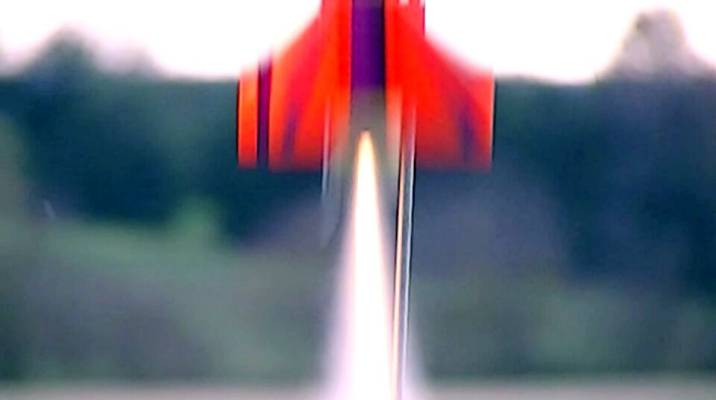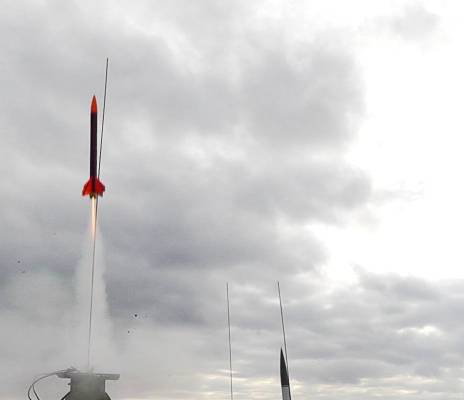The Cyclone: This is a modern Almost-Ready-to-Fly kit from Quest. The length and weight of this model is on par with the Estes Alpha, but a slightly smaller diameter. It has plastic fin assembly, stick-on body decal, streamer recovery. Uses 1/2A - C motors. Reasonably light model. I think this model could be called something else, but it came in a Quest starter kit and the other model was busted (I got a deal), so I used the "Cyclone" tube wrapper because it looked better, so now I just got used to calling it the Cyclone. It could just have well been called "Chain Reaction", the other decal. I modified the streamer bay with vent holes to install an Altimeter One. Notice also, to break up the monotony of the plain orange fins, I added the cheesy stripes to the fins using leftover sticker material from the body wrap. This model doesn't get much respect from me though; I didn't build it, just some minor assembly work. Not only is it simple and colored ugly, the plastic fins means it is a toy. A real rocket has balsa or wood fins and paint. I must admit though, it flies fast and high and is pretty rugged. This rocket has flown higher than NASA's VAB (Vehicle Assembly Building) in Cape Kennedy Florida – and that was only with a B6-4!
| Flight Date: | 2012-11-04 |
| Rocket Name: | Cyclone |
| Flyer's Name: | Rich DeAngelis |
| Motors: | B6-4 |
| Expected Altitude: | 540 Feet |
| Wind Speed: | 14.00 mph |
| Launch Site: | Penn Manor School Lancaster PA |
| Actual Altitude: | 536 Feet |
Often with this rocket in the cold air, the thick plastic streamer gets stiff and doesn’t unfurl or gets stuck in the tube, so this time I packed it very carefully, only satisfied on my third attempt to squeeze it and the shock cord and the Altimeter Two into the small body tube. This time I noticed the wobble of the rocket on the launch rail because the molded plastic lug is too large, making a mental note to try a 3/16 rod next time. This is an odd lug size for such a small, light rocket.
It lifted off well and quickly accelerated at a peak of 20.1 Gs, averaging 7.2 Gs for the 0.9 second burn of the motor. Very fast! It reached a speed of 137 mph and coasted for 4.3 seconds while flying at a moderate angle into the wind.
Ejection occurred at 503 feet and it came to a peak of 536 feet with the streamer unrolling completely this time. The apogee was higher than any other rocket I have flown using the B6 motor, although it did not beat its own record of 541 feet. It did set a new speed record for the B6 motor though.
With the short streamer it fell to the ground at 19 mph. During that time I watched the strong winds carry it very far downwind. It landed about 350 feet downwind after a flight time of 23.5 seconds. Absolute success.
| Stage | Motor(s) |
|---|---|
| 1 | Estes B6-4 |
 |
 |

